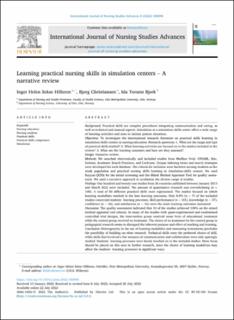| dc.contributor.author | Hilleren, Inger Helen Sekse | |
| dc.contributor.author | Christiansen, Bjørg | |
| dc.contributor.author | Bjørk, Ida Torunn | |
| dc.date.accessioned | 2023-02-16T09:12:03Z | |
| dc.date.available | 2023-02-16T09:12:03Z | |
| dc.date.created | 2022-08-23T21:56:51Z | |
| dc.date.issued | 2022 | |
| dc.identifier.uri | https://hdl.handle.net/11250/3051356 | |
| dc.description.abstract | Background Practical skills are complex procedures integrating communication and caring, as well as technical and manual aspects. Simulation at a simulation/skills center offers a wide range of learning activities and aims to imitate patient situations. Objectives To investigate the international research literature on practical skills learning in simulation/skills centers in nursing education. Research questions: 1. What are the range and type of practical skills studied? 2. What learning activities are focused on in the studies included in the review? 3. What are the learning outcomes and how are they assessed? Design Narrative review. Methods We searched electronically and included studies from Medline Ovid, CINAHL, Eric, Embase, Academic Search Premiere, and Cochrane. Unique indexing terms and search strategies were developed for each database. The criteria for inclusion were bachelor nursing students as the study population and practical nursing skills learning in simulation/skills centers. We used Rayyan QCRIt for the initial screening and the Mixed Method Appraisal Tool for quality assessment. We used a narrative approach to synthesize the diverse range of studies. Findings One hundred and twenty-one studies from 26 countries published between January 2013 and March 2022 were included. The amount of quantitative research was overwhelming (n = 108). A total of 50 different practical skills were represented. The studies focused on which learning modalities resulted in the best learning outcomes. Only 8.5% (n = 7) of the included studies concerned students’ learning processes. Skill performance (n = 101), knowledge (n = 57), confidence (n = 34), and satisfaction (n = 32) were the main learning outcomes measured. Discussion The quality assessment indicated that 10 of the studies achieved 100% on the mixed method appraisal tool criteria. In many of the studies with quasi-experimental and randomized controlled trial designs, the intervention group received some form of educational treatment while the control group received no treatment. The choice of no treatment for the control group in pedagogical research seems to disregard the inherent purpose and effect of teaching and learning. Conclusion Heterogeneity in the use of learning modalities and measuring instruments precludes the possibility of building on other research. Technical skills were the preferred choice of skill, while skills that involved a fair measure of communication and collaboration were only sparingly studied. Students’ learning processes were barely touched on in the included studies. More focus should be placed on this area in further research, since the choice of learning modalities may affect the students’ learning processes in significant ways. | en_US |
| dc.language.iso | eng | en_US |
| dc.rights | Attribution-NonCommercial-NoDerivatives 4.0 Internasjonal | * |
| dc.rights.uri | http://creativecommons.org/licenses/by-nc-nd/4.0/deed.no | * |
| dc.title | Learning practical nursing skills in simulation centers – A narrative review | en_US |
| dc.type | Peer reviewed | en_US |
| dc.type | Journal article | en_US |
| dc.description.version | publishedVersion | en_US |
| cristin.ispublished | true | |
| cristin.fulltext | original | |
| cristin.qualitycode | 1 | |
| dc.identifier.doi | 10.1016/j.ijnsa.2022.100090 | |
| dc.identifier.cristin | 2045498 | |
| dc.source.journal | International Journal of Nursing Studies Advances (IJNS Advances) | en_US |
| dc.source.volume | 4 | en_US |

